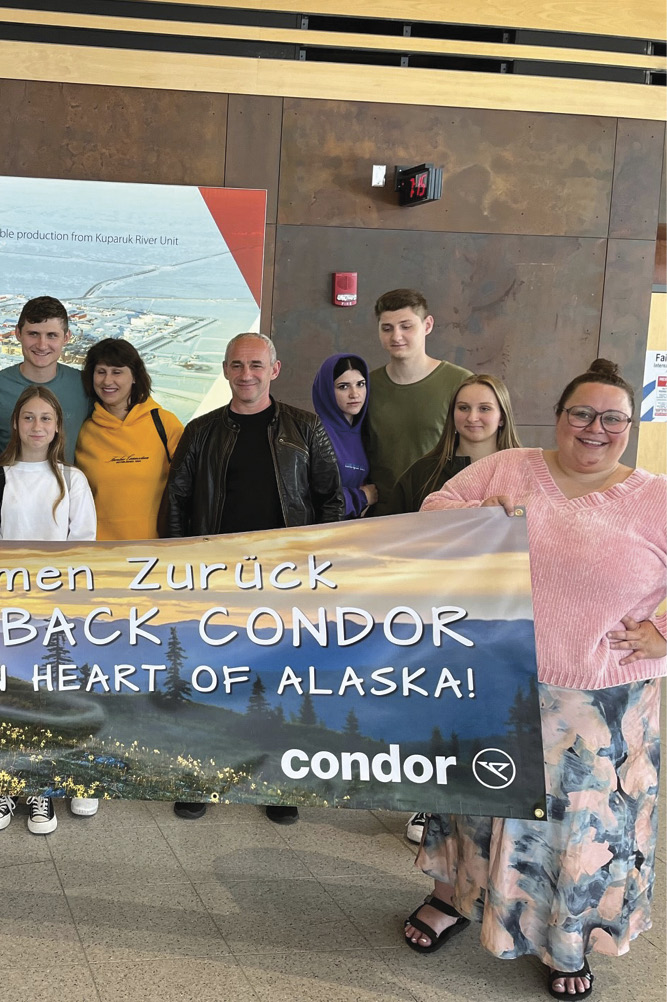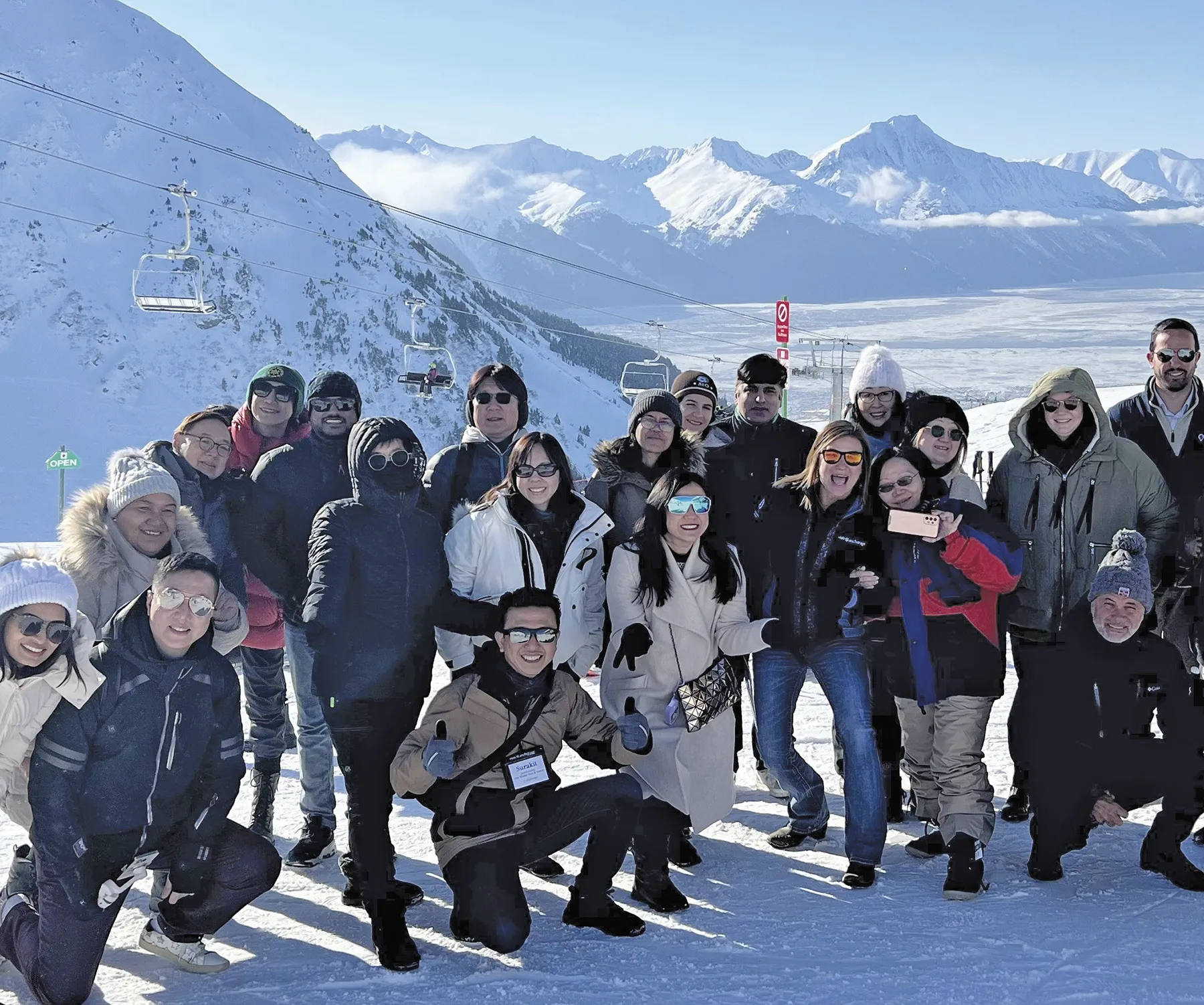hether it’s the lure of the northern lights, the chance to catch a king salmon, or the opportunity to view bears in the wild, Alaska attracts a significant number of visitors each year. Of more than a million people who visited in 2022, about 10 percent of the total was made up of international travelers. Those tourists may be seeking experiences that differ from what in-state or domestic travelers want to see in Alaska, so destinations statewide have adapted to that global clientele.
To attract international tourists, Visit Anchorage takes a number of different approaches.
“The number one thing we do is destination training; we want vetted operators to be really informed about what it means to travel to Alaska,” says Kasser. “For example, I was recently in Las Vegas at the RTO [Receptive Tour Operator] Summit where I had meetings with thirty-five international operators to discuss their needs. For some, working with Alaska Latin Tours might be the right fit; others want to work directly with tours out of Prince William Sound or a specific flying service like Rust’s or K2. We help them make those connections.”
Visit Anchorage also holds organized sales blitzes during which they travel to a country or a series of countries and host events with travel trade and media.
“For years, we traveled to four major cities in Japan and to Korea and China to garner local government support as well as provide destination training and to help operators make tourism connections,” says Kasser. “A lot of it is just being in front of people and making them feel welcome while showing them how our members fit their travel needs.”
Visit Anchorage also hosts meetings for international buyers, such as the Go West Summit, which visited Anchorage this past February. The event included a pre-FAM (familiarization tour) in Southcentral, as well as events at the Alaska Native Heritage Center, the Alaska Railroad, and local breweries.
“These types of events are great for introducing our destination to tour operators; they can meet our members that provide dog mushing services, fat tire biking tours, hiking trips in Chugach State Park, and more. It creates a lot of buzz and excitement around our products,” says Kasser.
Visit Anchorage also maintains international contractors in Australia and New Zealand, German-speaking Europe (an industry term that encompasses significant travel from Austria, Belgium, and Switzerland in addition to Germany), and Japan, and those contractors provide information to the local travel trade and promote Alaska.
Explore Fairbanks also works with international media, most often these days from German-speaking Europe. “Those media members come to Fairbanks on a pretty regular basis during the summer,” says Scott McCrea, president and CEO of Explore Fairbanks. “Prior to the pandemic, we were getting strong interest from China, primarily with social media influencers who are significant in that market.”
Depending on the country, Explore Fairbanks works with both group travel organizers and independent travelers.
“In the case of Japan Airlines, we were primarily looking at group travel, but there are more independent travelers within the German-speaking markets,” says McCrea. “In the four years leading up to COVID, we also saw a growing international market in mainland China and hired a contractor in Beijing to represent us there for three years. There’s a lot of potential there in terms of numbers.”
Alaska English Adventures

“The result of our efforts in Germany led to Condor Air having direct service from Frankfurt to Fairbanks for the past twenty-two years,” McCrea says. “We’ve also invested in the Japan market in the past, where we had a strong presence in the winter as a result of aurora tourism. That led to us working with Japan Airlines to have direct charters to Fairbanks from Japan.”
Visitors from those two countries were also common in Anchorage, according to Kasser, but that’s changed. “Historically, Japan and Germany were our number one markets, but that was surpassed about six years ago by the Australian market,” he says. “That market is fairly affluent and tends to take very long trips, usually six to eight weeks, and they rarely stay in one place.”
Australians are not alone in freely spreading around their dollars (Aussie or US). “International visitors tend to stay longer, spend more, and provide higher value versus those travelers who stop into Anchorage for one or two nights before getting on a cruise ship,” Kasser adds. “International travelers see Alaska as a destination versus a port—and while some are frugal when it comes to accommodations, they spend a lot on big-ticket items, like flight-seeing.”


Explore Fairbanks
“We’re now working with markets that we haven’t worked with before, like Latin America and India, which are currently two of the core international markets for travel to the United States,” says McCrea. “We recently did our first sales mission to both those countries with Brand USA, and there was high interest in Alaska.”
McCrea adds that bringing a new market to fruition can take years. “The key is to have a consistent presence the best you can and to maintain a regular working relationship—with a focus on training and education—with the key tour operators in those markets,” he says.
Visit Anchorage is also exploring emerging markets, including India. “It’s financially prudent to grow new markets. For example, we’re seeing some early independent travelers from the California tech industry traveling with their families from India, and we want to meet their needs,” says Kasser. “India is largely vegetarian, so food is a concern when traveling.”
As a result, when trying to grow the Chinese market, Explore Fairbanks worked with Mandarin-speaking full-service tour companies in the state, such as Alaska Skylar Travel and Aurora Expeditions. “They speak the language and know the market in terms of culture, and it’s very helpful to be able to partner with a business that has that knowledge,” says McCrea.
Alaska Step-on Guides, for example, provides city tour guides, foreign language guides, and multi-day tour guides in several languages. Alaska Travel Connections offers guides who speak French, Italian, Swedish, German, Portuguese, Spanish, and more, and Alaska Latin Tours provide summer and winter tours in Spanish. Businesses like Go North specialize in renting motorhomes to German visitors.
Brad Schmitz, founder and owner of Anchorage-based Alaska English Adventures, created his own niche to attract international visitors. After teaching English in Korea, he realized that he could combine his love of Alaska with visitors’ desire to learn the English language.
“After working for Princess in Alaska and then teaching in Korea, I learned firsthand what a huge market there was for a language program in the United States,” he says. “I loved Alaska, so I started to wonder what it would take to combine outdoor adventure with ESL [English as a Second Language] education.”
Working with his friend Sam Barney, a teacher from Fairbanks, the two began making friends with international tour operators in Anchorage who had outreach into Korea, Japan, China, and Europe. Unfortunately, then COVID-19 hit, and the company began a pen pal outreach program instead.
Schmitz found students in foreign countries learning English on Facebook who were looking for other students to be pen pals with, especially in Western countries. Schmitz connected students in Alaska with those in Germany, and the program grew to include outreach to students in Turkey, Poland, France, Hungary, Kenya, Brazil, Taiwan, Italy, Spain, and Vietnam. Students in Homer, Seward, Fairbanks, and multiple schools in Anchorage now take part in the program.
“While this hasn’t led to any international students coming to Alaska yet, that is the goal,” says Schmitz. “While these kids are working on their language skills as pen pals, they are also becoming volunteer marketers. As they get to know each other, the friendships will build, and down the road, we expect to schedule weeklong trips in Alaska for these kids to visit.”
Alaska English Adventures is tentatively listing tours on its website for 2023, and it plans to hit the ground running in summer of 2024 by bringing students from countries all over the world to Alaska.
“What I’ve learned over the past several years networking with ESL communities is that language acquisition and education best happens in action,” says Schmitz. “When a student is learning English out in the world, it’s more memorable, whether they’re whitewater rafting the Nenana River in Denali, ocean kayaking in Seward, or watching calving glaciers. Those experiences complement language learning.”
Visit Anchorage

“Because of the long history of Japanese travelers coming to Alaska to see the aurora, several airlines have tried to offer direct service from Asia to Anchorage,” says Kasser. “In particular, we’ve been working with Northern Pacific Airways to do an Icelandair-type model, where they gather passengers at Narita International Airport and fly them directly into Anchorage before they continue onto northern California.” Northern Pacific, Anchorage-based sister airline of Ravn Alaska, is still planning its debut overseas routes.
“According to the data we’ve been able to mine, there is a huge amount of traffic between major cities in Japan and northern California,” Kasser says. “We would be getting direct service and a certain number of seats for a year-round operation coming through Anchorage. We’ve been to the altar on this many times, but we’re hopeful about this one.”
The travel industry also hopes that direct service from Reykjavik, Iceland to Anchorage will be re-established, as Icelandair pulled out of the Alaska market during the pandemic but is expected to return. “There is a lot of value in that, but to do it they’ll have to pull planes from other areas. Finding accommodations for crews is also pretty challenging; rates for two-star hotels can be over $200, with some pushing $400.”
Like other efforts to facilitate international travel to the 49th state, the work put in is generally met with a great payout. As Kasser points out: “The route from Alaska to Reykjavik and back was one of the highest performing routes for airlines; they were getting top dollars for tickets.”